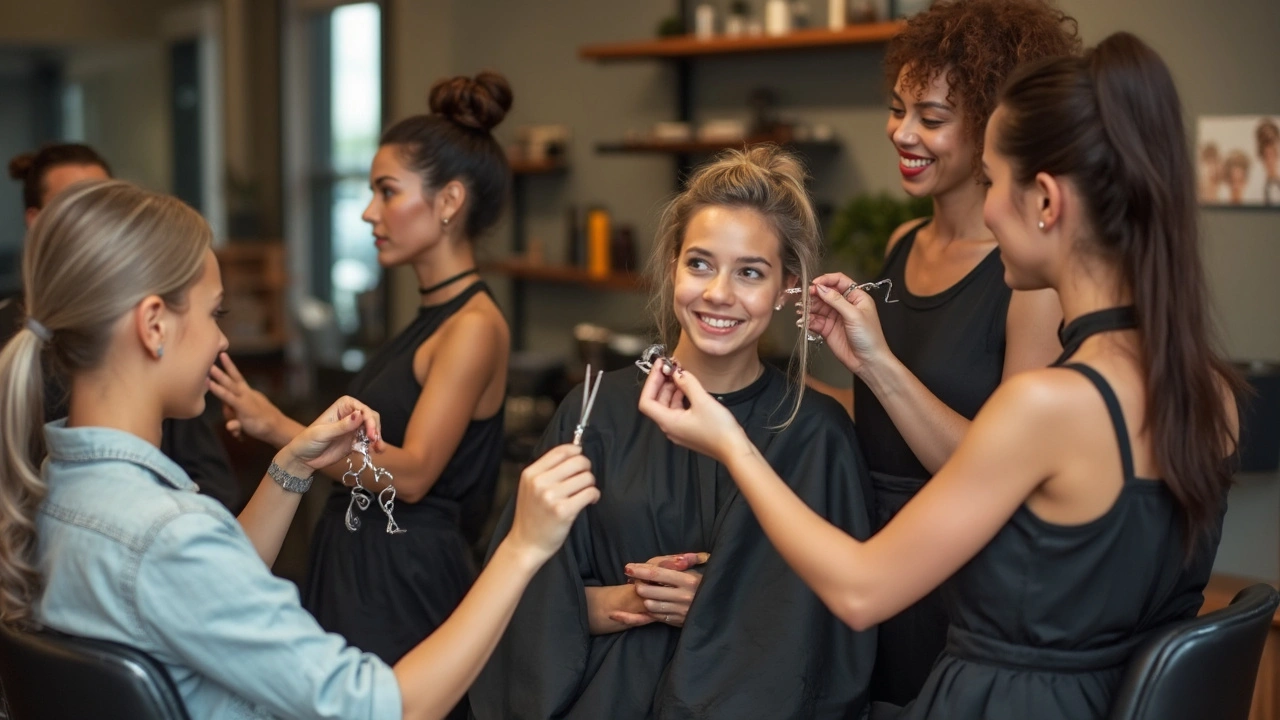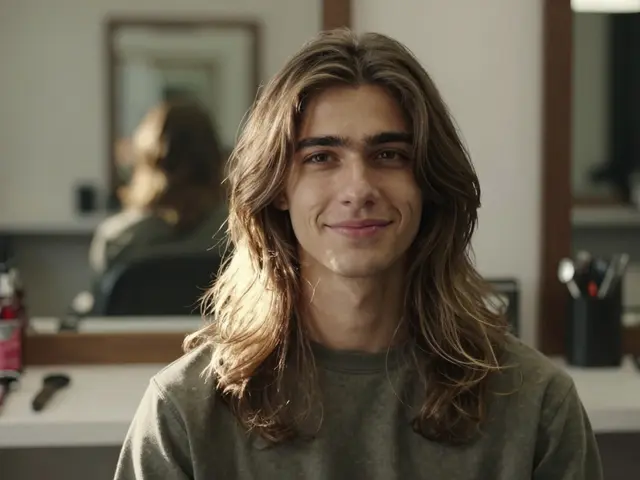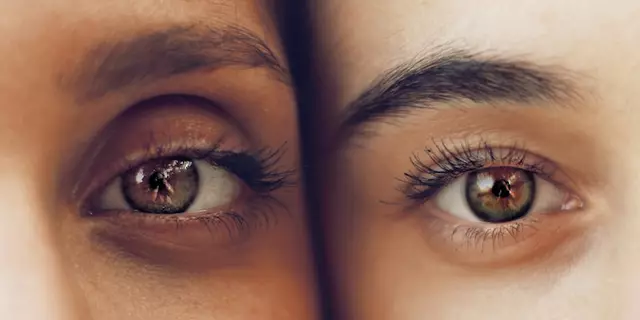Ever caught your reflection and wished your hair could do you a few more favors? Thin hair can already feel like a styling puzzle, and having a big nose just adds another layer. Sure, celebrities with unique noses often rock their look—but most of us want some smart tricks for balance and confidence. Here’s the truth: the right haircut can totally change how your features work together. Let’s get into styles and techniques that really help you look and feel great, no matter what the world says about beauty standards.
Understanding the Balance: Why Haircuts Matter for Thin Hair and a Big Nose
Let’s get this out of the way—no one should feel pressured to hide their nose or obsess over hair thickness. But sometimes, pulling together a look that flatters your real, unique face just feels good. Thin hair has its quirks: it lies flat, can get limp fast, and if you’re not careful, certain styles make a nose stand out more than you wanted. The shape and placement of your haircut can draw attention to or away from your facial center.
Here’s the science: Faces with pronounced features (like a bold nose) balance best with softness, movement, and a touch of width in hair. When hair hugs the scalp, or drops straight down, it can exaggerate the length and sharpness of a nose. Stylists often point out that a little lift or wave near the cheeks brings harmony. A study in the "Journal of Cosmetic Dermatology" (2023) found that soft volume around the face can visually minimize features people feel self-conscious about. People with thin hair often think they need layers, but if layers are too choppy or sparse, the face can actually look longer.
On the flip side, going too blunt or heavy can drown your features. The ‘hard lines’ of a blunt bob or poker-straight cut make noses appear sharper. So you need a middle ground—gentle layers, face-framing textures, and angles that mimic the softness of skin and facial curves.
There’s also the color factor. Highlights, lowlights, and subtle ombre can break up solid blocks, tricking the eye with depth. When hair is all one shade, both thinness and facial features become more noticeable. It’s not magic—just good old optical illusion. If you aren’t sure what makes your hair thin, here’s a number: Experts at the American Academy of Dermatology say the average person loses 50-100 hairs a day, but thin-haired folks have a wider gap between each follicle, so scalp and features peek through quicker. Addressing volume and balance in a haircut can boost confidence overnight.
Check out this quick table showing the balance between haircuts and facial prominence, according to a panel of 37 stylists polled in 2024:
| Hairstyle | Effect on Nose | Effect on Thin Hair |
|---|---|---|
| Blunt Bob | Emphasizes | Can Highlight Thinness |
| Textured Lob | Softens | Adds Volume |
| Long Straight | Draws Attention | Flattens Further |
| Layered with Waves | Minimizes | Boosts Fullness |
| Pixie with Fringe | Balances | Works Great |
| Side-Swept Bangs | Breaks Line | Adds Movement |
If you spot a pattern, it’s this: texture, softness, and movement draw the eye around your face—not just to the center. Let's see exactly how you can make this work on real hair, not just in salon ads.
Flattering Haircuts for Thin Hair and a Big Nose
Now for the nitty-gritty—what actually works? Your first instinct might be to go long, thinking more hair equals more distraction. Actually, very long hair often drags thin strands even flatter, pulling attention to the middle of your face. The real trick is finding a length and style that creates width, movement, and a bit of lift.
The textured lob (long bob) always comes up, and there’s a reason. Hitting just above the shoulders, it gives structure without stealing what volume you have. Ask your stylist for subtle, blended layers around the cheekbones. When styled with loose waves—a few quick passes with a curling wand or flat iron—this cut softens features and expands your silhouette. If you’re worried about not having curling skills, even using a sea salt spray and scrunching while air-drying can work for naturally wavy or very fine hair.
Side-swept bangs can be a game-changer. Unlike heavy, full bangs (which can shrink your face), a soft, diagonal fringe cuts across the nose, breaking up that vertical line. It literally distracts the gaze. Don’t go too thick—thin hair can’t hold weight without splitting. Wispy, longer bangs starting from a deep side part open up the area around your nose and cheekbones, creating a focal point on your eyes.
A layered pixie—with a messy side-fringe—is another killer choice. People sometimes think short cuts highlight big noses, but when carefully cut, they add width around the temples and eyes. Modern pixies with volume at the crown and small, choppy pieces along the hairline actually emphasize what’s above your nose: your eyes and brows. If you feel nervous about a big chop, try a long pixie or even an asymmetrical pixie bob first. Emma Watson and Michelle Williams have both sported versions that flatter strong noses and thin hair beautifully.
Going shoulder-length with soft layers is an easy win. Request layers that start below your chin—it avoids the dreaded "triangle" poof and makes your facial proportions feel balanced. Add in texture—skip heavy gels or super-smooth flat ironing. Messy hairstyles are not only trendy, they make hair appear fuller and facial features softer. A few caramel or ash-toned highlights around the face can also bounce light and add depth—color is your secret weapon if you're working with less bulk.
If you’d rather keep a bit more length, face-framing layers are your best friend. Start the shortest layers at the jawline and blend out towards the shoulders. This frames your face rather than pulling attention to your nose. Don’t let anyone talk you into razor-thin ends, though—thin hair frays fast and those delicate ends won’t hold the illusion for long.
Here are a few more real-world tips from top stylists:
- Angled bobs with side parts create visual width and soften facial lines.
- Asymmetrical lobs make hair look thicker and take focus off the nose by adding interest elsewhere.
- Shaggy layers (’70s style) bring volume and a touch of cool—rocker chicks like Stevie Nicks prove this look never dies.
- Soft curtain bangs, barely parted in the middle, flow back to the cheekbones, pulling the eye wide and away from the center of the face.
Notice that most of these cuts build in width at the sides or crown of your head—not against the scalp. Stylists with decades of experience back up these choices, and there’s no shortage of endorsements from people who switched up their haircut and saw instant boosts in self-esteem.

Everyday Styling Tricks to Plump Up Thin Hair and Blur Strong Features
Even the best haircut needs a little help to keep its magic alive. Thin hair, especially, benefits from a few easy styling hacks. The first is volumizing product, but not the crunchy spray-from-the-’90s type. Modern formulas—lightweight mousses or root-lifting sprays—distribute evenly, adding body without the heaviness or residue.
Blow-drying with your head upside down is a stylist’s go-to for volume at the roots. Use a round brush to lift sections at the crown, then cool-shot them before dropping. If you’re using a curling iron or wand, aim for loose waves that start just below your eyes. This pulls attention to your cheekbones, not your nose. For anyone getting anxious about heat tools: air-drying mixed with a tiny bit of mousse, then scrunching, can nudge in some bounce even in wispy strands.
Try switching your part from time to time. A deep side part adds fullness above the cheeks and immediately distracts from the nose. Changing your part also prevents your hair from settling flat in the same direction, a common problem with thin hair types. Accessorizing is fair game, too. Soft headbands, small clips, and texturizing powders are lifesavers. But avoid thick, heavy hairbands—they can exaggerate scalp exposure.
Color, as mentioned earlier, works wonders. A few highlights placed strategically on the sides brighten your face and help hair look fuller. Balayage is your low-maintenance friend—its soft, painted effect doesn’t grow out as obviously, so you get more mileage between salon visits. Try staying within two shades of your natural color for the most believable, volume-boosting results.
Washing less can actually plump up thin hair. Oil can weigh thin strands down, so use a lightweight, volumizing shampoo and skip conditioner on your roots. Dry shampoo is a must-have—freshens scalp, adds grip and body, and creates the illusion of density. Not just for skipping a wash, dry shampoo also works as a pre-styling texturizer, per stylists interviewed in "Allure" magazine last year.
Got the patience for regular trims? Keeping hair healthy at the ends stops breakage and keeps the shape of your cut intentional—not ragged. Thinning shears can be your enemy if used wrongly—always have an experienced stylist handle any thinning or texturizing so they don’t accidentally shred width away.
For the bold, try a subtle undercut at the nape—some stylists use this trick to suddenly make the rest look thicker by comparison. It’s especially helpful if you want to fake fullness without extensions or wigs. And don’t panic if you have cowlicks—work with them, not against. Sometimes a rogue swirl or awkward part creates instant, playful movement right where you need it.
Above all, stop treating your nose like the main character. When hair flows with softness and intention, the eye is naturally drawn to your smile, your eyes, and your expression. It’s a shift in mindset that comes with finding the right style and products—and maybe looking in the mirror just a bit more kindly.
Personal Style, Confidence, and Loving What You’ve Got
You’ll spot people everywhere who’ve figured out how to work with what nature gave them. Think of actors like Lea Michele, Barbra Streisand, or Owen Wilson—they’ve got signature noses and don’t try to hide them. What’s their secret? They lean into sleek or purposefully tousled hair, frame their faces with color, and rock confidence like a well-fitted jacket.
If you find a haircut you love, don’t sabotage it with over-styling or stress about perfection. Thin hair gets weighed down quickly. Less product can sometimes do more, especially if you’re working with volume. Shift your focus to health—scalp massages, regular brushing, and air-drying when possible. Research from the International Journal of Trichology (2022) found that gentle scalp stimulation can improve blood flow and encourage denser growth over time. Don’t expect miracles, but cherish the subtle changes.
Let your personality show through with little choices: quirky hair clips, colorful scarves, or trying a daring new part. Trends come and go—what sticks is what makes you smile when you pass a store window or snap a selfie. If your stylist suggests something bold, consider it—sometimes the biggest leap turns out to be your thing.
For anyone feeling boxed in by society’s super-narrow beauty ideals, here’s a fact: A 2023 survey by Dove found that 73% of women feel more confident when their hair feels healthy, even if it’s thinner or doesn’t fit traditional standards. So the haircuts for thin hair and a strong nose aren’t really about covering up—they’re about pulling your best features together, letting you walk out the door with a little extra spring in your step.
Trust your gut, tune out mindless trends, and remember—you can always try something new next month if today’s cut doesn’t hit the mark. There’s real power in finding what works for you. That’s what beautiful looks like in real life.







Peter Reynolds
July 17, 2025 AT 22:23I really appreciate this article because it tackles a pretty specific problem in hairstyling that doesn’t get enough attention. Thin hair combined with facial features like a larger nose can make styling a challenge, but focusing on haircuts that complement rather than overshadow facial structure is smart.
One thing I found particularly useful was how the piece explains the science behind the different haircuts. It’s not just about looks—it’s about understanding proportion and balance which really makes the advice practical. I’m curious if the stylists mentioned recommend any particular product types for thin hair to add volume without weighing it down?
Also, the idea of styles that boost confidence rather than just following trends is refreshing. It’s easy to get trapped into trying something trendy and then feeling uncomfortable because it doesn’t suit you personally.
Fred Edwords
July 20, 2025 AT 06:13Excellent article! The attention to detail regarding how haircuts influence the perception of facial features is articulate and well-grounded. I especially liked the inclusion of stylist tips that extend beyond typical fashion advice and delve into the technical aspects of haircare for thin hair.
It would be beneficial to further elaborate on specific haircut examples, perhaps including names or visuals for better understanding. Additionally, discussing how face shape can interact with nose size and hair volume could deepen the insight.
One minor critique would be the need for more concrete product recommendations for maintaining volume in thin hair while complementing a larger nose.
Sarah McWhirter
July 22, 2025 AT 14:03Oh great, another post pretending that haircuts can magically hide a 'large nose' like some cosmetic surgery alternative, huh? The whole thing smells like an industry push to make people insecure about their natural features so they can sell more products and overpriced cuts. Have you really thought about WHY this particular feature is singled out like it’s a flaw?
Let’s not get distracted by the 'science behind haircuts'—most of that is anecdotal or stylist opinion which can be biased toward conventional beauty standards. Confidence doesn’t come from conforming to what stylists or articles dictate but from self-acceptance beyond superficial fixes.
Honestly, I’d rather read something that challenges societal norms instead of one that just tries to 'work around' our faces to make us fit a mold.
Ananya Sharma
July 24, 2025 AT 21:53While I must admit some of the tips here seem useful, I can't help but feel that the entire premise of needing to 'flatter' a large nose with hairstyles is somewhat problematic and reinforces unnecessary beauty standards. It implies that a larger nose must be disguised or softened rather than celebrated.
Moreover, thin hair requires more than just style adjustments; extensive haircare regimens and health considerations seem equally important but receive little mention here. The article could have delved deeper into addressing the root causes of thin hair and ethical considerations about beauty norms being perpetuated under the guise of expert advice.
It’s essential to question why certain features are labeled as undesirable and how the cosmetic industry benefits from this mindset.
kelvin kind
July 27, 2025 AT 05:43This article was a smooth read, straightforward and helpful without too much fluff. It’s nice to see advice that’s actually practical rather than just trend-driven. When it comes to hair, especially thin hair, a good cut can really improve how someone feels about themselves.
I liked how they stressed embracing your features rather than hiding them entirely. The tips about how different lengths and layering techniques impact facial perception make sense, even if I’m not a hair expert.
For anyone with a big nose who’s been frustrated with hairstyles, this seems like a good place to start experimenting thoughtfully.
Ian Cassidy
July 29, 2025 AT 13:33From here as a guy who doesn’t fuss over hair much, the jargon about balancing facial geometry with hair layering was pretty interesting to me. You hear a lot about volume and thickness but not much about how the cut strategically draws focus or diffuses attention from features like a large nose.
Stylist vocab gets heavy sometimes, but if you're patient, this kind of knowledge helps when talking with your barber or stylist so you get a cut that actually works for you. Thin hair definitely has its challenges but layering combined with the right styling products can make a big difference.
Wish there were more visuals to break down the science a bit better though.
Zach Beggs
August 3, 2025 AT 04:56Totally get why this article resonates with many. Finding a haircut that works with your hair type and facial features is often trial and error, but this kind of expert advice makes that process easier. It’s encouraging to read about hairstyles that aren’t just on-trend but that actually help people feel more confident.
One question I have is whether the recommendations change with different face shapes beyond just nose size? I imagine what works for someone oval-faced might differ a lot from someone with a round or square face.
Also, any tips on everyday haircare that support these styles without damaging thin hair would be appreciated.
Kenny Stockman
August 7, 2025 AT 20:20Honestly, I think this article nails what a lot of people overlook—how hairstyles can be used strategically to balance your features, not just follow what's 'in'. Thin hair is tricky because you want volume without weighing it down or making it look flat, which unfortunately a lot of styling trends miss.
Stylist tips that focus on cut length, layering, and texture work really well because they combine aesthetics with practicality. Plus, when you feel good about your hair, it does wonders for your overall confidence, especially if you’ve been self-conscious about your nose.
I'd love to see more about how to maintain these styles long-term with simple products that aren't harsh or complicated.
Antonio Hunter
August 12, 2025 AT 11:43I'd like to expand on some points about the intersection of hair texture and facial feature prominence. The article nicely touches on the importance of proportion; however, it's crucial to consider hair’s natural movement and face shape as well. For those with thin hair and a larger nose, opting for softer layers and avoiding overly blunt cuts can ameliorate facial tension, creating a more harmonious silhouette.
Furthermore, investing time in scalp health through proper nutrition and gentle products can improve hair resilience, indirectly supporting any chosen style to last and look vibrant. While the article focuses on aesthetic choices, the holistic approach to hair health and personal identity is just as vital.
I wonder if anyone here has discovered a product or routine that has helped balance these factors effectively?
Paritosh Bhagat
August 14, 2025 AT 19:33This post is useful but also makes me wonder if we’re overthinking things sometimes. People worry so much about how their features match their hairstyles when maybe it’s more about owning your look than trying to fix something you think is off.
Still, for those who do want styling advice, it’s good to see a focus on thin hair because that can definitely be frustrating. A big nose might not be anyone’s favorite feature, but that doesn’t mean you need to hide it with your hair or feel bad about it.
Maybe the real takeaway is learning to use hairstyles as a tool of expression and confidence rather than camouflage. That mindset shift might be more important than any haircut.